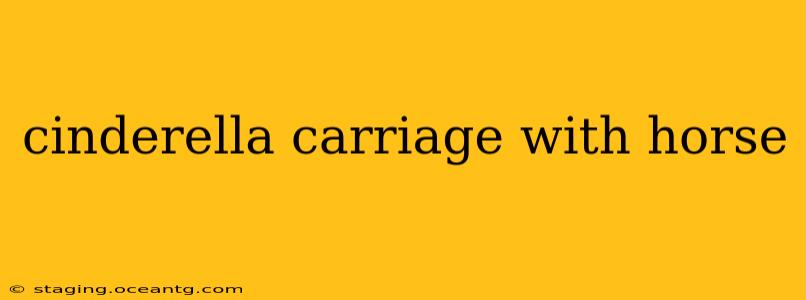The image of Cinderella's carriage, drawn by magnificent horses, is arguably one of the most enduring and beloved symbols in popular culture. But beyond the fairytale magic, lies a rich history and a fascinating exploration of symbolism. This post delves into the details of Cinderella's iconic transportation, exploring its evolution, significance, and the enduring fascination it holds.
What kind of carriage was Cinderella's?
Cinderella's carriage isn't explicitly described as a specific type in the original fairy tale. However, depictions across various adaptations consistently portray it as a pumpkin carriage, transformed by magic. This choice is significant. Pumpkins, humble and commonplace, represent transformation and the potential for unexpected beauty. The carriage itself, often shown as elegant and ornate despite its humble origins, further reinforces this theme of metamorphosis. Different versions of the story might offer slightly different designs, but the core idea remains: a magnificent carriage arising from unexpected origins.
What kind of horses pulled Cinderella's carriage?
Again, the original tales are less specific. However, most adaptations depict Cinderella's carriage being pulled by beautiful white horses. White horses often symbolize purity, grace, and nobility, aligning perfectly with the fairytale's themes of virtue and transformation. The magnificence of the horses further amplifies the magical aspect of the scene, creating a visually stunning and memorable image.
Was Cinderella's carriage really a pumpkin?
This is where things get interesting. The idea of a pumpkin transforming into a carriage is a powerful visual metaphor, but it's crucial to remember that this detail is a later addition, not present in the earliest versions of the story. The original tales focused more on the magical transformation and less on the specific object. The pumpkin, however, became a crucial element in later adaptations because of its visual appeal and its symbolic resonance with transformation and unexpected beauty.
How was Cinderella's carriage made?
The magic, of course! The process of transforming a pumpkin into a carriage is never explicitly explained, adding to the enchanting and fantastical nature of the story. The lack of detail enhances the magic and leaves room for individual interpretation and imagination. This mysterious transformation emphasizes the power of magic and the possibility of unexpected wonders.
What happened to Cinderella's carriage at midnight?
This is the dramatic climax of the story. At the stroke of midnight, the magic spell breaks, and the carriage transforms back into a humble pumpkin, the horses back into mice, and the coachman into a rat. This swift reversal highlights the temporary nature of magic and emphasizes the importance of adhering to limitations or deadlines, a common theme in fairy tales. It also underscores the fragility of the dream-like experience and the consequences of exceeding limitations.
What is the symbolism of Cinderella's carriage?
The carriage's symbolism is multi-layered. It represents transformation, hope, and the possibility of achieving dreams, even from humble beginnings. It also symbolizes social mobility, as the carriage allows Cinderella to attend the ball and interact with the prince, a social sphere inaccessible to her before the magical transformation. The eventual return to its original form serves as a reminder that even the most magical experiences are temporary, emphasizing the importance of appreciating the present moment.
The enduring appeal of Cinderella's carriage lies in its ability to capture the imagination and symbolize the power of dreams and the magic of transformation. It's a powerful image that continues to resonate across cultures and generations, reminding us of the possibility of achieving our dreams, no matter how humble our beginnings.
